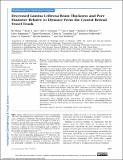Decreased Lamina Cribrosa Beam Thickness and Pore Diameter Relative to Distance From the Central Retinal Vessel Trunk
Author(s)
Wang, Bo; Lucy, Katie A.; Schuman, Joel S.; Sigal, Ian A.; Bilonick, Richard A.; Kagemann, Larry; Kostanyan, Tigran; Lu, Chen David; Liu, Jonathan Jaoshin; Grulkowski, Ireneusz; Fujimoto, James G.; Ishikawa, Hiroshi; Wollstein, Gadi; ... Show more Show less
DownloadWang-2016-Decreased Lamina Cri.pdf (656.1Kb)
PUBLISHER_CC
Publisher with Creative Commons License
Creative Commons Attribution
Terms of use
Metadata
Show full item recordAbstract
Purpose: To investigate how the lamina cribrosa (LC) microstructure changes with distance from the central retinal vessel trunk (CRVT), and to determine how this change differs in glaucoma.
Methods: One hundred nineteen eyes (40 healthy, 29 glaucoma suspect, and 50 glaucoma) of 105 subjects were imaged using swept-source optical coherence tomography (OCT). The CRVT was manually delineated at the level of the anterior LC surface. A line was fit to the distribution of LC microstructural parameters and distance from CRVT to measure the gradient (change in LC microstructure per distance from the CRVT) and intercept (LC microstructure near the CRVT). A linear mixed-effects model was used to determine the effect of diagnosis on the gradient and intercept of the LC microstructure with distance from the CRVT. A Kolmogorov-Smirnov test was applied to determine the difference in distribution between the diagnostic categories.
Results: The percent of visible LC in all scans was 26 ± 7%. Beam thickness and pore diameter decreased with distance from the CRVT. Glaucoma eyes had a larger decrease in beam thickness (−1.132 ± 0.503 μm, P = 0.028) and pore diameter (−0.913 ± 0.259 μm, P = 0.001) compared with healthy controls per 100 μm from the CRVT. Glaucoma eyes showed increased variability in both beam thickness and pore diameter relative to the distance from the CRVT compared with healthy eyes (P < 0.05).
Conclusions: These findings results demonstrate the importance of considering the anatomical location of CRVT in the assessment of the LC, as there is a relationship between the distance from the CRVT and the LC microstructure, which differs between healthy and glaucoma eyes.
Date issued
2016-06Department
Massachusetts Institute of Technology. Department of Electrical Engineering and Computer Science; Massachusetts Institute of Technology. Research Laboratory of ElectronicsJournal
Investigative Opthalmology & Visual Science
Publisher
Association for Research in Vision and Ophthalmology (ARVO)
Citation
Wang, Bo, Katie A. Lucy, Joel S. Schuman, Ian A. Sigal, Richard A. Bilonick, Larry Kagemann, Tigran Kostanyan, et al. “Decreased Lamina Cribrosa Beam Thickness and Pore Diameter Relative to Distance From the Central Retinal Vessel Trunk.” Invest. Ophthalmol. Vis. Sci. 57, no. 7 (June 10, 2016): 3088.
Version: Final published version
ISSN
1552-5783